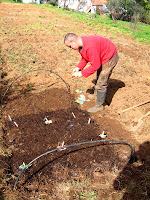

Things are warming up. The seedlings are popping up and learning how to be plants and the chickens are laying some tasty eggs and enjoying the joys of free range living, maybe a bit too free range comfort… check out our chicken blog here.
 We are balancing things at Pan de Trigo with time spent in Alburquerque finishing off the house we have there, ready to rent it out as a holiday home (we’ll let you know when the website and the house are ready).
We are balancing things at Pan de Trigo with time spent in Alburquerque finishing off the house we have there, ready to rent it out as a holiday home (we’ll let you know when the website and the house are ready).
 While we were gone last week, a lot of poo arrived, goat poo, ready to dig in to the new vegetable patches, now it all needs to be moved to each different area. Where are the WWOOFERS when you need them?
While we were gone last week, a lot of poo arrived, goat poo, ready to dig in to the new vegetable patches, now it all needs to be moved to each different area. Where are the WWOOFERS when you need them?
 So, potatoes. Growing potatoes means lots of digging, even after ploughing. Of course you need good seed potatoes too, we have a Dutch variety from a bag we split with the neighbours and some old potatoes that look like aliens which have sprouted in our little store room over the last few months. We have picked a fresh patch of land to grow the potatoes on and of course we have dug in loads of that fresh fertiliser. We’ll carry on with that next weekend.
So, potatoes. Growing potatoes means lots of digging, even after ploughing. Of course you need good seed potatoes too, we have a Dutch variety from a bag we split with the neighbours and some old potatoes that look like aliens which have sprouted in our little store room over the last few months. We have picked a fresh patch of land to grow the potatoes on and of course we have dug in loads of that fresh fertiliser. We’ll carry on with that next weekend.


















